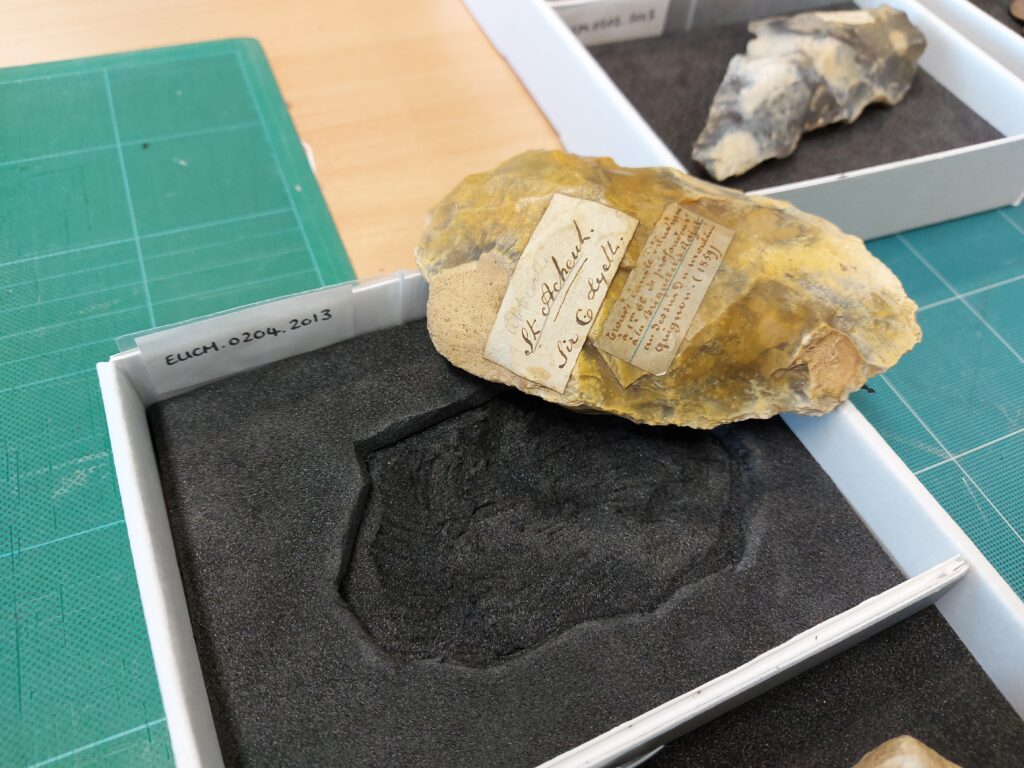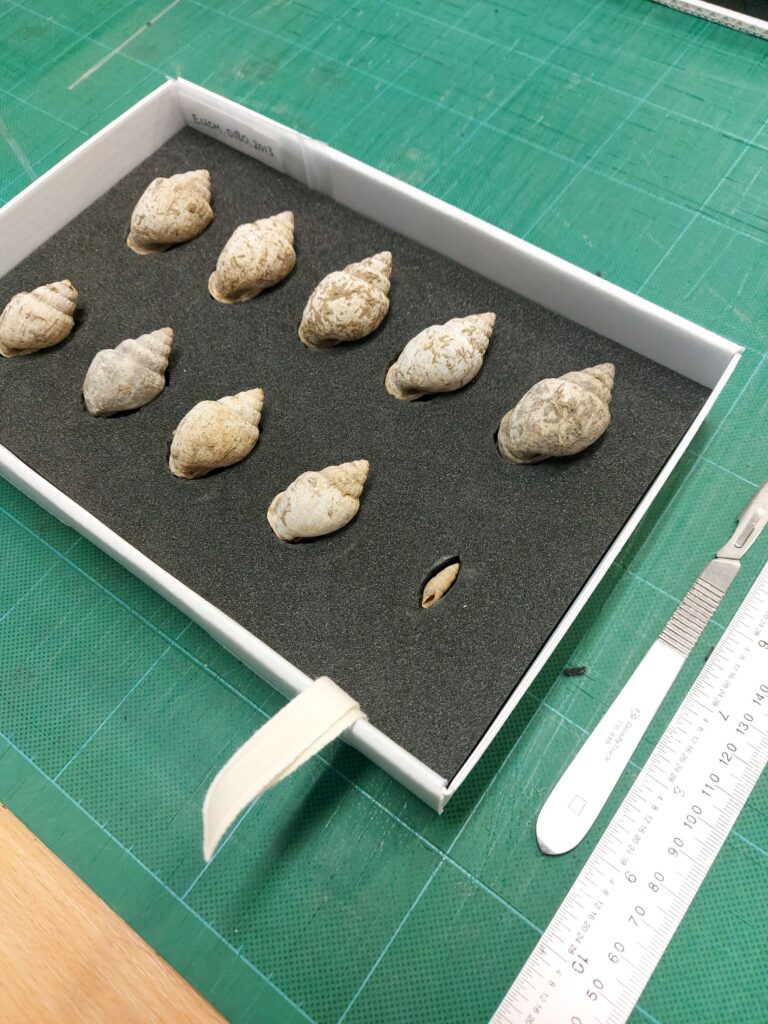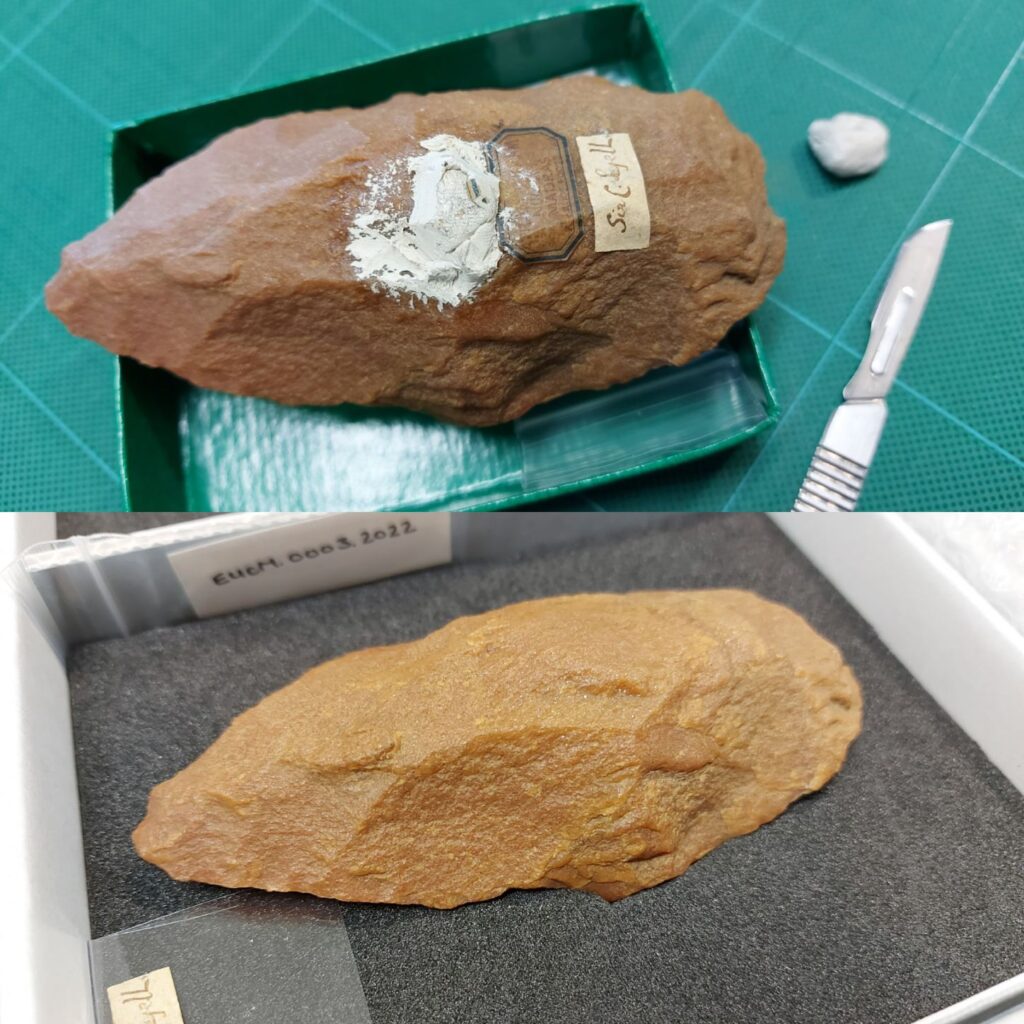In this post, Technician Robyn Rogers discusses her bespoke mounting and rehousing of loose-leaf papers from the University’s decorated paper collection. Robyn’s first post about working through the collection’s bound volumes can be seen here. If you are interested in learning more about the historic uses, production and trade of decorated paper, you can visit the online exhibition on this collection, curated by Elizabeth Quarmby Lawrence here.
Category Archives: Preventive Conservation
Collections Care Task Days
In this post, Technician Robyn Rogers discusses the first events in series of Collection Care Task Days at the University of Edinburgh Heritage Collections.
Sustainable Exhibition Making: Recyclable Book Cradles
In this post, our Technician, Robyn Rogers, discusses the recyclable book cradles she has developed as part of the conservation team’s ongoing work to make exhibitions at the University of Edinburgh more sustainable.
Giving Decorated Paper a Home … Rehousing Books and Paper Bindings
In the first post of this two part series, our Collection Care Technician, Robyn Rogers, discusses her Decorated Paper rehousing project. If you want to learn about the uses, production, and trade of decorated paper, you can visit the online exhibition on this collection, curated by Elizabeth Quarmby Lawrence, here. Look out for the second post in this series soon, in which Robyn will discuss mounting loose leaf papers.
Glazy in Love: Rehousing the Emma Gillies Collection
Today we have the first instalment of a two-part series from Collections Care Assistant, Sarah Partington. In this post, she talks about rehousing a collection of ceramics made by the artist Emma Gillies. Sarah is working at the CRC on a government-funded Kickstart placement and will be sharing two of the projects that she has completed during her time with us.
This year, I have had the absolute joy of working with an exciting collection of ceramics by Emma Gillies. Previously, Emma Gillies was thought of largely in relation to her brother, the renowned painter and past Edinburgh College of Art Director, William Gillies. However, due to a discovery of a large body of her work, we are now able to gain fresh insights into her practice as a prolific artist in her own right.
A significant amount of work has already been done to catalogue and house the collection since its rediscovery in 2013. My role in this project built upon this foundation of existing collections management and care work, and was focused on two main tasks: checking and updating the existing inventory, and rehousing the ceramics in such a way that they could be accessible visually, whilst also being secure and stable.
Homes for Rocks – Rehousing the Lyell Geological Specimen Collection
Today we have the first installment of a two-part series from Joanne Fulton. Joanne is here on an 8-week internship funded by the John R. Murray Charitable Trust to help with the conservation of the collection of Sir Charles Lyell (1797 – 1875).
It is a privilege to handle objects that have been worked on by people in the past, to experience the connection and witness their working and learning processes. Therefore, it has been a fascinating opportunity to work on the rehousing of the Lyell Geological Specimen Collection which consists of various specimens from flint implements and axe heads, to shells and raindrop traces.
As previously outlined in these blogs, Sir Charles Lyell (1797-1875) was a hugely significant scientific figure in the 19th century. Amongst others, Lyell corresponded and was a close friend of another well known figure, Charles Darwin, a name closely linked to a number of the shell specimens within the collection I’m rehousing.
These specimens were collected or given to Charles Lyell on his many geological excursions. They were then used to inform his geological research, and they continue to inform learning and research within the University of Edinburgh today. When observing the many documents in the Lyell collection, I’ve found drawings of the same specimens I’m rehousing, illustrated by Lyell in his papers and notebooks.
In the first week I calculated I should be aiming to complete at least 5 objects per day to finish within the 8 weeks of my internship, as I had to bear in mind that within the 168 objects to be rehoused there are groups of items – here I’m largely referring to the shells – that make up a single object. However, as I reach the end of week 4, I’ve found I’m now completing over 10 a day due to more efficient preparation.
The materials I have been using to rehouse the specimens includes card tray compartments and plastazote, a type of foam used in archival repackaging. I have several sizes of trays, however there are 6 specimens which are too large for the largest of trays and need their own custom boxes. I’ve made these myself with card and corrugated card.
My process for rehousing a specimen begins having prepared the tray and two layers of plastazote to fit within. I then cut into the plastazote as appropriate to the rock. Using a white pencil I mark out where I need to cut through the top layer of plastazote, and then using a sharp scalpel, I carve into the thicker bottom layer. This carving is continued until the specimen sits tight and will continue to do so in the future when the specimens are returned to their storage.

A sharp scalpel is needed to create a neatly cut support for each specimen (EUCM.0204.2013)
All this cutting creates a lot of off-cuts from the plastazote. Rather than wasting them, I shall be reusing them as padding for a Tyvek book cushion in order to make my project more sustainable.
Previous to my rehousing, some of the rocks were held in small green trays of a standard size, often not suited to the actual size of the specimens and offering no added protection. The shells, which I shall be rehousing next week, are in small red boxes.
Included with many of the specimens are extra notes and labels of various origins – some of Lyell’s own handwriting – which also need to be housed with the object as part of their history. When this is the case, I create a third layer of plastazote to house this paper note slipped in a melinex sleeve, carving a little recess for it to sit flat. I then attach cotton tape to the middle layer so the user can lift the object to see the paper note when needed.

Shells after rehousing: A note stating these shells were collected by Darwin is stored underneath (EUCM.0180.2013)
The majority of these specimens are in good condition – they are rocks and so robust by their composition- the labels, many handwritten by Lyell, and other attachments to the object are less so. Many are in need of repair having suffered losses, crumpling, and have become detached from the specimen. This is a problem I shall be tackling in the second half of my internship; repairing the tears and losses, as well as reattaching the labels with an adhesive.
There have also been a few messy surprises and oddities in the collection, with one rock having a large amount of white tack attached, unfortunately this was also stuck to the rock’s labels. This white tack was removed, and the same tack was used to remove the tiny amounts left in the small crevices on the rock surface. I carefully removed the labels from the rock and the tack, removing the unwanted and potentially damaging tack mechanically from the paper labels.

Photo during and after removing white tack from one of the specimens (EUCM.0003.2013)
Having recently graduated from the paper conservation course at Northumbria University, its been a rich learning curve working with objects such as the geological specimens. In my second blog, I plan to examine the method of reattaching the loose labels to the specimens as well as the finalisation of the rehousing within the second half of my internship.
Putting the Pieces Together: The Challenges of Working on Architectural Models (Part 1)
Today we have the first instalment of a two-part series from our Projects Conservator, Mhairi Boyle. In this first instalment, Mhairi discusses the assessment and the first treatment steps involved in the conservation of three large architectural models created by Percy Edwin Alan Johnson-Marshall (1915-1993) (Accession numbers PJM/PJMA/EUD/B/9.1; PJM/PJMA/EUD/E/1; and PJM/PJMA/EUD/B/1.5).
Since beginning my contract as Projects Conservator, I have been involved in a wide variety of work. From meeting and greeting art couriers from Greece to examining a frog muscle specimen, there’s never been a dull moment. One of the great things about working with the Centre for Research Collections is the collaborative nature of my job. I work with archivists, curators, librarians, and anyone and everyone who needs the advice and assistance of a conservator.
Most recently, I have been working with Collections Care Assistant Sarah Partington, Preventive Conservator Katharine Richardson, and Archivist Grant Buttars to assess and treat three large architectural models of the University of Edinburgh. The models were created by the architect and previous Professor of Urban Design and Regional Planning, Percy Edwin Alan Johnson-Marshall (1915-1993), between 1962 and 1976. They provide a fantastic snapshot into the developing landscape of Edinburgh during this period – Grant pointed out several building proposals which had never gone ahead, and most excitingly, the location of the Burke and Hare Tunnel which is visible from the within the Law School building in Old College. The aim of the conservation treatment is to stabilize the models so that they can be safely transported to another University building, keeping them accessible to researchers who wish to view them.



The models provide a snapshot of potential extensions and changes to the University from 1962-1976.
As a paper conservator, I usually work on flat objects such as letters and maps, as well as repairing books in-situ when required. It has been challenging, and very interesting, to examine and treat such large composite objects.
The models have several inherent vices, which means that there are elements which will inevitably decompose and become more fragile over time. They can be considered ephemeral objects: like film posters and newspapers, the materials used to create the models were never intended to stand the test of time. The lichen used to create the trees has become very brittle and fragile over time, and in some cases, now has a post-apocalyptic feel to it. Low-quality papers, cards, and adhesives have been attached to the wooden components of the models. One of the models was exposed to the elements in one of the University’s lobbies, wherein a rogue bird popped in to leave its ‘mark’ on the roof of one of the models.

Poor quality adhesive hardens and fails over time.

The lichen used to create the trees has decomposed, becoming brown and blackened.

The hole on the bottom left of this photo is a peg hole, where a loose element was once attached.
The largest model is composed of removable elements, attached in place by wooden pegs. We had a lot of fun locating the proper sites for some of the detached elements, hearkening back to my first ever lockdown days which were filled with jigsaws and puzzles. The loose and missing elements of the models were extensively documented, and most pieces were reattached after consultation with Jonathan Santa Maria Bouquet, the University’s Musical Instruments Conservator and resident wood expert. This will be discussed in detail in the second blog of this series.
After removing loose debris with a Museum Vacuum and using a smoke sponge to remove surface dirt, Sarah and I got to work reattaching loose paper elements with wheat starch paste, and thicker card elements with EVA adhesive.

Collections Care Assistant Sarah Partington re-adhering loose paper elements.
Working on these models has been a great chance to work closely with colleagues from different departments. In the second and final blog of this series, I will examine the different adhesives used in this project and the reattachment of some of the loose elements.
Interactive Integrated Pest Management
The final post from Sophie Lawson, our conservation Employ.ed intern, in this week’s blog…
We are approaching the end of our Conservation E-learning project, with a completed trial resource being prepared to go to our first focus group. The resource focuses on providing the user with an introductory level of knowledge of Integrated Pest Management, with a focus on the problem of insect pests in Special Collections storage. More specifically, the resource aims to provide a wider knowledge of the following: an introduction to Integrated Pest Management (or IPM), how an IPM plan is implemented, pest identification procedures and the quarantine and treatment procedures within an institution.

The interactive menu-based home screen of the trial e-learning resource

Quarantine and Treatment clickable menu screen

Identification clickable menu screen
E-learning with Employ.ed
Today we hear from Sophie, our first ever Employ.ed student in the conservation studio…
Hi, my name is Sophie Lawson and I am currently the Conservation E-learning intern at the Centre for Research Collections at the University of Edinburgh. During my time of ten weeks here in the Conservation Department I will be creating an electronic learning resource on the subject of Integrated Pest Management (IPM). My internship is part of the Employ.ed programme, which is a University run scheme that supports students’ career development, providing work experience whilst working towards attaining the Edinburgh Award. I am currently going into my third year of my undergraduate degree in History and have an interest in special collections, particularly in digitisation and use of technologies in the heritage sector.
The University’s IPM plan is integral to the storage of rare and unique collections, being a tested method to monitor and control insect pests and mould activity in collections that, if left unmonitored or untreated, could cause irreversible and expensive damage to collection items. As part of a preventive conservation programme, IPM is an effective way to reduce damage and cost, and to minimise intervention with special collection items. An effective IPM plan will enable institutions to have greater control over and knowledge of pest activity in their facility, making pest prevention and treatment much more effective. One of my goals through creating this e-learning resource is to aid this accumulation of knowledge of pest activity throughout the department, with the hope that the resource will be used for internal staff training for a basic overview of our IPM plan, how it works and why it is so important.

Using a microscope to identify pests
So far in my internship I have been able to gain invaluable insight into the field of Conservation, having spent some time in the Historic Environment Scotland’s Conservation Studio, as well as our own in the CRC, and even being able to try my hand at some surface cleaning and making boxes for rehousing books! More specifically I have gained a great deal of knowledge about Preventive Conservation, having researched Integrated Pest Management and the theory behind it for the content of my e-learning resource. In addition to this, I have been able to shadow my supervisor, Katharine Richardson, as she carried out pest trap inspections as part of our IPM Plan – and was even able to get a closer look at the kind of pests we found!

Trap used to monitor for pest activity
For the remainder of my internship I aim to create a user directed, interactive program, and experiment with implementing different types of media such as games and video tutorials to create an engaging and educational resource. I hope that through the completion of this project we are able to generate a broader knowledge of IPM and its importance amongst the University’s Centre for Research Collections staff, as well as introduce new methods of e-learning and training styles to be used in the department in future projects.
Introducing our New Projects Conservator – Helen Baguley
This week’s blog comes from Helen Baguley, the newest member of the conservation team…
I have been recently employed by the University of Edinburgh on a 12-month contract as a Projects Conservator. This exciting and varied role means I am predominantly located in the University Collections Facility (UCF), and off-site storage building in South Gyle. I will be working within the rationalisation project, looking at the collections which are currently housed there, such as rare books and university archives. I will also be assisting the musical instrument conservator and art department in their work. This will consist of carrying out conservation work and supervising volunteers under the direction of the Preventive Conservator, Katharine Richardson.

Collection items on a shelf at the University Collection Facility
